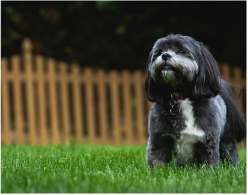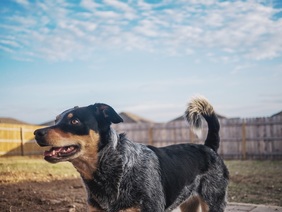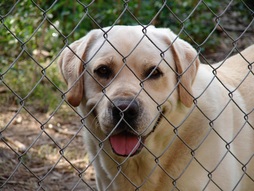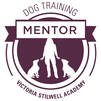A blog for all things dog-related: training, behavior, fun new doggie items, veterinary information and, of course, ways to enhance your relationship with your best four-legged friend!
1) The invisible fence may keep your dog IN your yard, but will not keep other animals or predators OUT, which is something I think is important to recognize in the area of the Hudson Valley where we live. With wildlife being so prevalent, you might not want your dog regularly eating or rolling in deer poop or trying to chase after a skunk or racoon due to the possible transmission of disease. Or worse, trapped in a situation where he feels he can't get away if a predator (like a coyote or bear) enters your yard and corners him. This is where I think having a real fence will at least keep many other animals out and keep your dog safer. Especially if you live either in a highly wooded area (where predators and deer are plenty) or in the center of town (where there's a lot going on directly outside your yard, including neighborhood cats and other people walking their dogs).
3) If you have a less confident/insecure dog in general, the invisible fence can also be problematic. I'm reminded of two situations in particular with clients where the invisible fence caused less desirable effects: - With one young and sensitive dog, the owner thought he was getting the hang of the invisible fence and respecting the boundaries, so she decided not to put the electric collar on the dog when he went out into the yard. Well, he got curious about a scent trail and without the beep or shock as a reminder, he kept going past the boundary line to follow it. When she then tried to intervene and call the dog back to her however, he must've remembered where he was and that if he crossed that line he was going to get a shock, so he took off down the street! Luckily we were able to get him back in a short amount of time, but even as we carried him across where the boundary line was, he got very tense and cowered in my arms, anticipating the shock of re-entering his yard. Not a good association to have if you want him to return to the yard once the “heat of the moment” takes him out. - The second circumstance was with a dog who has quite a bit of anxiety to begin with. The invisible fence was helpful because it kept him within the confines of the yard so he and the kids could play ball, and the dog would respect the boundary line because he feared the shock. He feared the shock SO much, however, that you couldn't get him past the boundary line for anything, even if he didn't have his electric collar on. He wouldn't go down the driveway to take a walk with the family around the community or to get the mail across the street - he would simply stop at the property line and bark out of frustration and grow more anxious until the family returned. If they wanted to take him anywhere off the property, they had to put him in the car, and even riding in the car as he crossed the property line he would get extremely stiff and cower, expecting the shock (which, of course, never came because his collar was off). Taking both of those scenarios into consideration, if you have a more sensitive dog who may grow more anxious because of the invisible fence, then in my mind that defeats the purpose of having him outside in the yard to begin with. And, rather than fostering a confident dog, you are helping to create a dog who builds in anxiety. For example, I know of one dog who gets extremely stressed anytime she hears any kind of beeping sound, since she associates it with the beep warning of the upcoming shock of the electric collar. 4) If you rely on the invisible fence, it's important to do periodic checks to ensure that the batteries in the electric collar have enough power and that the electricity is working. Otherwise you run the risk of the power being out/battery being dead, and if you have a head-strong dog who no longer gets a shock, he may just be brave enough/insistent enough to wander out of the yard. All that said, however - If you're planning on being outside with your dog every time he's in the yard, then this is where the invisible fence doesn't have as many downfalls, in my opinion. You can be there to supervise him and help him understand the boundaries without relying solely on the equipment to do it for you. This will still enhance your relationship with your dog and allow you to do things like play fetch, etc off leash, but the invisible fence will only be a "backup" system in case he tries to get too far away. Since he won't be left unsupervised, you will also still be able to catch all the appropriate teachable moments, like how to come back to you when he sees a person/dog walking on the street or something else of interest (which will allow you to work with self-control, impulse control, and even counter-conditioning/desensitization to teach him what you expect of him in the yard).
With an actual fence, you may have to consider the make and height of the fence to have the best chance at success. For example, if you have a large, lean and active dog that is good at jumping, having a 4’ picket fence may be easy to climb, whereas a 6’privacy fence will not offer him any footing to scale the height. It’s also important to note that some dogs are diggers and may try to burrow underneath an actual fence if left alone for too long a time. In this event, I find it helps if the dog has a specific spot to dig (such as a sandbox) and isn’t left alone in the yard unattended without adequate mental stimulation.
If having a real fence is not an option for you, but the invisible fence doesn’t sound like a good match for your dog either, I recommend purchasing a long line (a training leash that comes in a variety of lengths ranging from 10’ to 50’). With a long line, your dog can still play fetch, hike and run in the yard, but he is still attached to you in the event you need to help reel him in from undesirable situations. He can still have a good time and you can rest assured that he is safe and can’t find trouble (or have trouble find him!).
0 Comments
Your comment will be posted after it is approved.
Leave a Reply. |
AuthorMaria Huntoon, CBCC-KA Archives
April 2020
Categories |



 RSS Feed
RSS Feed






